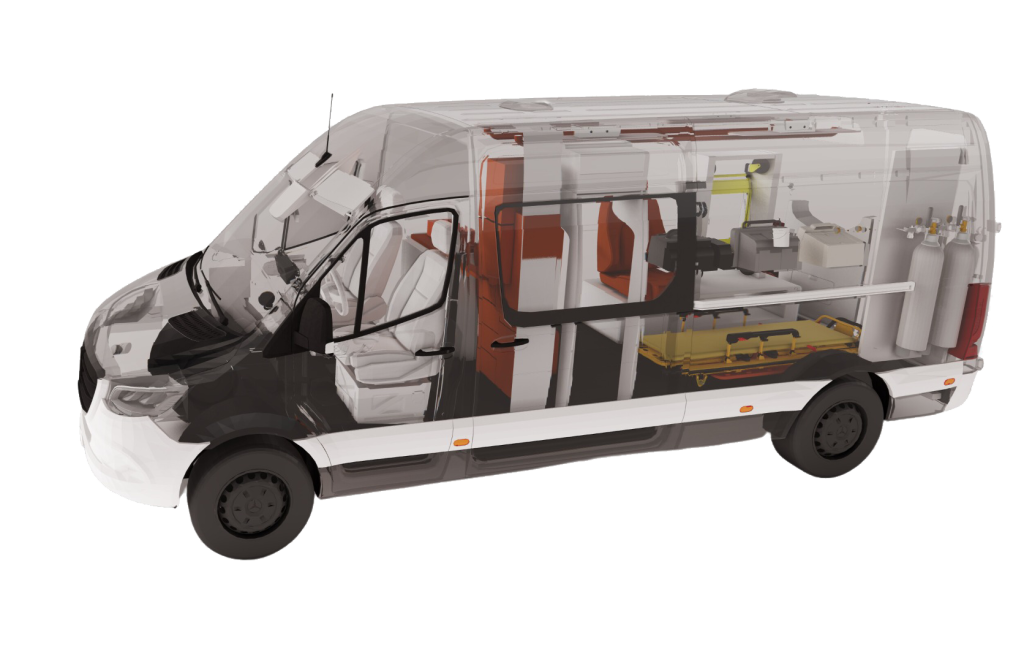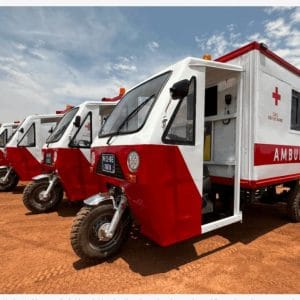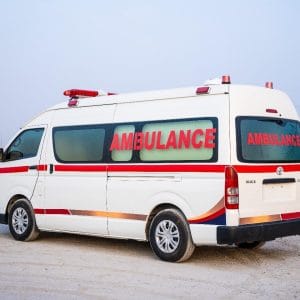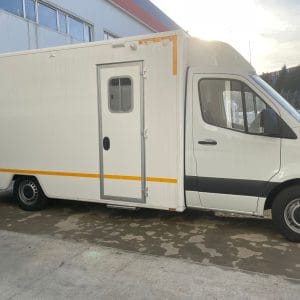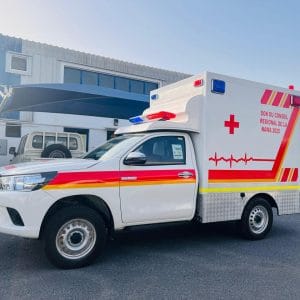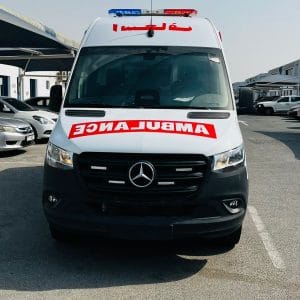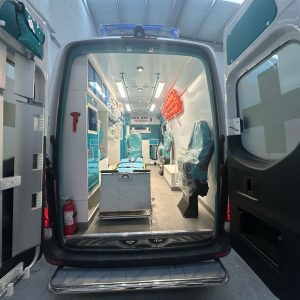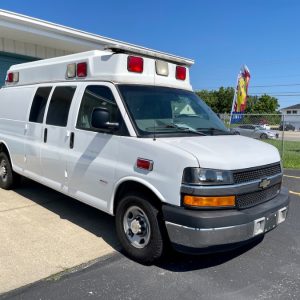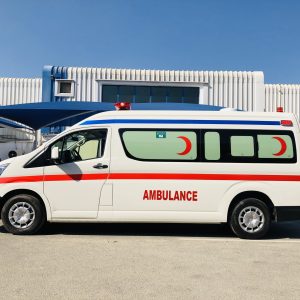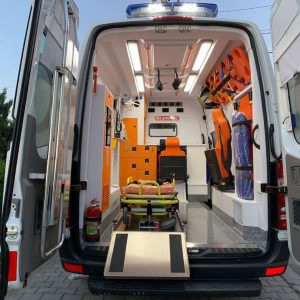1. Introduction
Medical Equipment in Mercedes Ambulances; This essay focuses on the integration of medical equipment into Mercedes ambulances. Nowadays, interest in such advances is great. Many companies and research centers are engaged in this activity, which is governed by the “Fourth Industrial Revolution” – the term used by Davos economist Professor Klaus Schwab. There are several bases for this activity: the development of ambulance vehicles in terms of integrating medical equipment, the production of new ambulances with standards specific to this vehicle, digitizing information management systems, and the entire IT process.
Ambulance vehicles are specialized in integrating entire equipment, including transport and communication, diagnostic, therapy, and life-support. The challenge lies in the size and placement of the equipment, which depends on the available space in the cabin, climate conditions, and the strategic and tactical approach to medical events. This includes rescue tools and medical equipment for pre-hospital work in mountain or marine zones, stadiums, highways, rural areas, big cities with heavy traffic and congestion, daytime or nighttime operations, and for adults, children, pregnant women, infants, and in environments with chemical, biological, radiological, and nuclear agents, with a risk of microorganism propagation. The proposed new criteria for integrating medical equipment and instruments in Mercedes ambulances, using parametric design and linear equations, is to offer the chance and opportunity to provide fast and high-quality prehospital medical care. The integrated mobile Intensive Care ambulances are designed to rapidly and easily initiate the “Golden Hour” medical care, according to national and organizational norms in the rescue field and medical protocols.
1.1. Background and Significance
An ambulance is a vehicle that is equipped with medical facilities and is used to transport patients to healthcare facilities. In recent years, emergency medical services (EMS) have received increasing attention as a result of the COVID-19 pandemic. The concept of an ambulance was first introduced by the French, when they launched horse-drawn installations with medical equipment. The modern ambulance evolved from two major changes in the 1960s: the advent of mobile intensive care units (ICUs) and emergency rooms. Paramedics equipped ambulances with basic medical extraction equipment and defibrillators, thus playing an important role in life saving. With the advent of new and readily available technology, ambulances today are able to diagnose on site to provide accurate and appropriate care.
Driving in a modern ambulance with advanced medical equipment allows doctors to take care of patients as quickly as possible with the best care, thus significantly reducing the likelihood of death and disability. In addition, the link between ambulance and hospital is important. Medical equipment usually includes invasive or non-invasive diagnostic devices, therapeutic devices, monitoring devices, and support devices. The medical equipment in the ambulance also plays a vital role in determining the risk of patient mortality, as well as the ability to improve medical outcomes in emergency medical conditions. Emergency medical equipment in an ambulance. Comprehensive and modern medical equipment can greatly support emergency medical procedures. Given this situation, research will be carried out to cater for the integration for medical equipment in Mercedes ambulances.
2. Design and Features of Mercedes Ambulances
Mercedes-Benz differentiates their ambulances through the design and features that are exclusive to the commercial vehicles of this brand. For example, these include the nearly vertical, recurved, fore-level wheel arch design that features a long wheelbase with a large load capacity vehicle. The chassis also includes special structural stiffness which is resistant to torsion or bending, and is also quiet and low in vibration. A front-wheel drive system with stability control is one that also directly affects driving comfort as well as the ability to overcome obstacles. An ambulance is a representative exponent of the latest generation, body shape, transformation solutions and interior design of Mercedes-Benz brand.
Inside the patient cabin, which is divided into two compartments with complete paramedic equipment and oversized travel comfort for the driver and paramedics, the integration of medical equipment is envisaged. Special attention was paid inside the ambulance to ensure the comfort and work of medical staff. Custom LED lighting and strip lights are installed in the ceiling of the module to identify each compartment, provide an abundance of light for operation and good visibility of all compartments. A single-bunk patient stretcher is placed at the rear, on which it is easy to move the patient, with a backrest adjustment and height to accommodate the patient during healing. Overall, the first responders compartment is configured to comfortably transport two adults lying down, each with a backrest angle above 30 with a simple patient tap. At the head of the seat opposite the double belt, modern technology allows a more effective connection to the screen on which the course will be displayed.
2.1. Overview of Mercedes Ambulances
Mercedes-Benz Vans offers ambulance solutions that adhere to the high, specific, and individual requirements placed on emergency medical services. The vans are robust, flexible, and tailored precisely to rescue and emergency services. The quality of Mercedes ambulances is reflected not just in their comfort, fuel efficiency, and innovative safety systems, but also in the specifications like Mercedes PRO connect, comfort, multimedia, seating capacity and load compartment capacity, engines, transmission, and dimensions. The front-wheel-drive ambulance with a permissible gross weight of up to 3.5 tonnes and a fixed roof already boasts 7 cm greater interior standing height and therefore even more working comfort. It houses its electrical and heating/air conditioning system under the car body, providing more space for medical equipment in the box body. Depending on the country-specific regulations, the car body at ex-works is prepared with a rail system for easy and, most importantly, TÜV-approved installation of the box body by external partners. With additional modern safety equipment as standard, more than enough space, and a chassis designed for safety, an emergency doctor can respond to emergency calls and take care of his patients quickly and comfortably.
The dimensions of Mercedes ambulances for sale are as follows. First, they come to an overall length of 2,550 mm, an overall width of 1,501 mm, and an axle ratio (gearbox) of 1,027 mm to 2,700 mm. Next, the distance from seat to steering wheel is 564 mm to 807 mm, and the distance from the seat to the pedals is 181 mm to 870 mm. It has a permissible gross vehicle weight (all the people and equipment loaded plus the weight of the vehicle itself) of 6,000 kg. The boxcan design, for better safety, includes additional seat belt bracket reinforcement between the side inner and outer aluminium profiles agencies. Mercedes-Benz Vans makes the vehicle pulsation system e-friendly, an insufficient floor height between 858 mm to 900 mm, and an interior standing height between 1,808 mm to 2,020 mm, compatible with any interior setup. The vehicle is powered by a four-cylinder turbodiesel engine that meets the Euro 6d and Euro VI emissions standards.
3. Medical Equipment Requirements
For the medical equipment in an ambulance, some requirements have to be respected. The vehicle is a moving platform which can be used for diagnosing and treatment of patients with emergency care. As first aid, it can be used in transferring patients from the site of injury to the hospital, and if needed, for house to house service. However, space, weight, and power supply are limited. As a result, the number of devices may also be limited. The number of devices at immediate disposal is discussed in the concept of the ambulance. The ambulance will be used for patients that show signs of potentially life-threatening conditions.
The required medical equipment has to be protected against mechanical damage and punctual overpressure. Furthermore, according to regulations, the patient side has to be disinfected every time the patient has left the ambulance. Relative ease of cleaning is required. Important prerequisites need to be considered in this process: the help of professionals should be very immediate (in terms of time, accessibility, and readiness), transport of the patient should be supported by the most up-to-date devices for immediate aid, and trained and experienced personnel of different qualification levels should cooperate. These prerequisites form the background for the requirements of the ambulance carrier.
The vehicle is generally equipped with the medical courier panel, including the B- and C-activated sockets. Also, D-activated sockets are to be installed. The electrical power for the medical devices is assured through three 12 Vdc independent lines from the battery converter.
3.1. Essential Medical Equipment
When designing an ambulance, the main task is to include all the necessary tools and devices which facilitate the medical staff with their work on-site and to the patient. The ambulance is part of the pre-hospital emergency care system. Inside the patient’s compartment, there is basic life support and advanced life support equipment (cardiac monitors, tube ventilation, automatic external defibrillators, resuscitation kits, oxygen therapy equipment, etc.). In addition to essential patient-care equipment, ambulances should also carry drug capsules, drugs, ECGs, stretchers, as well as equipment designed to measure arterial stiffness, blood glucose levels, stroke risk and other health indicators, as well as equipment for providing emergency medical care to patients. Some ambulances are mobile hospitals, equipped with an entire laboratory, an ultrasound, an X-ray machine, resuscitation tools, part of a surgical set, and can keep a dozen or so patients alive while being transported to hospitals.
The decision about the medical equipment in the ambulance is primarily the responsibility of the founding staff, depending on the profile of the unit and the scale of the provision of ambulance services. The physical state of the ambulance, the ability to carry out the necessary modifications after commissioning and compliance of all purchased equipment with the standards and regulations are also taken into account. The Ambulance Department accepts good practices and guidelines in the field of medical rescue. Above all, they are used in the continuing education of medical personnel. The minimum required medical equipment includes a portable suction aspirator, one- or two-chamber vacuum stretcher, and set of consumables: pressure pad splints, adult- and child-sized cervical collars, patient examination gloves, a bag for personal belongings, a fanny pack for the oxygen therapy unit, and an assortment of disposable or reusable bandages, dressings, and adhesive tape.
4. Challenges and Solutions
Not only have logistics played a role in the development of specialized equipment, but the challenge in developing a concept for the equipment has also had a broad impact. A uniform, efficient ambulance provides a continuous chain of medical service. The biggest challenges related to equipping the Sprinter turned out to be its size, the fixed headroom, and weight. Units can weigh a maximum of 3500 kg. FWA requirements dictated such a limit without exemption, as driving over the 3500 kg limit would require additional crew members and additional equipment. In some countries, an exemption does exist and ambulance weight limit can be up to 5000 kg, with the loss of driver’s B category to C category, while in Sweden it can only be up to 4100 kg. It is important to mention that the C1 Category is obligatory in the subsequent ambulance driver training.
Therefore, several medical equipment (i.e., ventilator, incubator) and monitoring equipment (i.e., EKG, capnograph) specifications have been included pursuant to the analysis and disaster medicine training (i.e., mobile emergency department). The communication devices specified for the ambulance will provide the crew with continuous links to the principal hospital and also the fixed communication devices in the ER (Emergency Room) for continuous advice. The main principle of operation for the future Disaster Medicine Centre was established as module treatment with self-contained equipment on wheels. Therefore, in principle, the cabin layout can be sold as an advanced system utilizing a few communication-electricity connections only. (The development of an NEMS for the ambulance itself was rejected.) The integrated specialized equipment (e.g., hydraulic stretcher, 230 V cabin) fully corresponds to basic emergency preparedness equipment.
4.1. Integration Challenges
Integration of medical equipment directly in the ambulance represents considerable challenges. First and foremost, in situ medical devices were usually built at the hospital, with only proper storage in the ambulance – where they were disconnected – for transportation; building equipment that can only be used in the ambulance is a rather new concept. Moreover, space is at a premium, and the use of numerous different equipment types draws attention to a series of other, equally important factors.
In a world becoming increasingly interconnected, electronic interoperability problems are forever present: magnetic resonance imaging and traditional pacemakers are not compatible, and computer tomographs with 16-detector matrices are not compatible with traditional stents. From measurements in our own fleet and talking to ambulance personnel, we have not noticed network-related faults in typical ambulance internal environments, typified by the Mercedes Sprinter. Nevertheless, this issue needs to be investigated further.
Medical waste transport is heavily regulated using purpose-built vibrant and power leak preserving containers. For efficacy, several vehicles carry modular bins and the solid structures are laid out to accommodate both apparatus and flexibly-placed material.
Accessibility is another point of interest. Simple, easily dislocated items, such as trauma bags, should be stowed transparently accessible and have the advantage of several container slots to enable transparency (i.e., visual location confirmation). More dangerous equipment for which the driver has no demand for access should be locked up. To meet regulations on disease control, it is recommended that the cabinet not be accessible from the driver’s or co-driver’s chair. Cab improves that primary and out-of-cabin equipment should be properly protected, as recommended for disease control.
Design will also have to take into account outsourcing holes, water and other contaminants from ambulances. For the future of emergency medicine’s dual job of ambulance nurse and car mechanic, improving technology will increase the demands on these individuals. In replacement of more conventional job skills, better electrical data will become necessary with age.
5. Future Developments
This project was intended as a step towards a fully integrated design of the treatment area and the medical equipment within the internal part of an ambulance. By integrating the equipment, it is possible to simplify the design, as the part of the treatment area where installation space is available will be largely determined by the size and placement of the largest pieces of equipment. The treatment area then has individual parts that are intended for a particular type of treatment and where equipment and furniture is placed around this activity.
In the concept of the internal integration of medical equipment, the possibilities for new technology were discussed. Based on the system specifications, the most important future developments are discussed below. Future ambulances with a development period of 5-10 years will become substantially different from current ambulances, probably incorporating new medical equipment which is not foreseen at this moment. This trend will continue, as technology rapidly develops. For example, in the past, the function of blood pressure registration and defibrillation was also in the domain of only highly educated personnel. It is possible that essential treatment will take place outside of the hospital and the function of these technologically advanced ambulance functions fits the staff’s levels of expertise.
5.1. Innovations in Medical Equipment Integration
The introduction of medical equipment into vehicles is a new specific direction in the use of advanced technologies, which is not widely used yet. Paravan was one of the first companies in Germany that develops specialized techniques and software for the patient’s independent use of medical equipment located in the vehicle. They implemented guiding technology with the help of a Leap Motion camera sensor. This sensor controlled the navigation in the user’s interface device, which is located in front of the passenger sitting in the middle of the car. Paravan still uses that technology in their modern mini-vans that can carry patients in wheelchairs.
New delivery methods, like the system “Ambulift,” for example, reduce delays in the service of Airbus aircraft. This necessitates its direct use after the plane has landed and its uninterrupted operation for a given time. Special medical equipment devices are placed directly in the plane and are no longer connected with the airport.
The future concept of transferring baggage (and simultaneously transferring patients on stretchers) from the aircraft to the airport building through a special corridor is now being introduced in practice. This future “antigravity bag,” now not used in its design, will become part of an airplane when dragging the baggage from a plane out of the airport terminal break, but not for transporting baggage. The cost of converting a full-size ambulance is exorbitant and realistically not financially feasible. The lightweight Mercedes Sprinter patient care unit with state-of-the-art spray design, infrastructure pursuit, capacity, and equipment are LTV EZ-Slider, a Spiral Aircraft Litter Transport System (SALTS) ambulance, and ground patient transfer conveyance system between the LTV and a service hospital.


